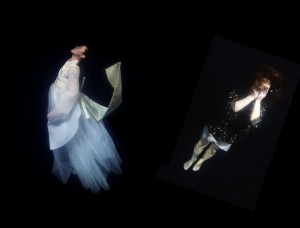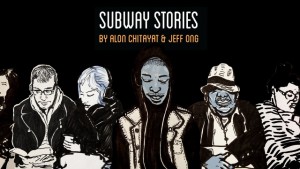
Alex Ingersoll, Dark Objects part of Currents 2015
Intimacy and Experience at Currents New Media Festival
A museum docent put a “special” ring on my finger and touched me intimately at Currents: The Santa Fe International New Media Festival. She was explaining how the communication technology Mutsugoto by Tomoko Hayashi works, and directed me to one of two beds draped with sheer white cloth, while she stood at the other. She told me to move my ring-hand over the bed, and as I did so, a line of light formed behind it on the bedsheets. Then, a sparkling sphere of color appeared, producing a second line. It represented the docent’s hand on the other bed and she proposed that we join our lines. If we did so, they would turn red. I hesitantly moved my hand toward hers.

Tomoko Hayashi, Mutsugoto
Now is a good time to admit that I’m somewhat of a Luddite, certainly not an early-adopter. I started using social media only five years ago, I don’t play video games, and I don’t have a smartphone. So, you may not be surprised to read that after attending Currents, I have the same doubts about new media art that I have about new media in general. In light of the fact that social media was instrumental in the Arab Spring and Occupy Wall Street, I also acknowledge that technology has value in the world, just as I acknowledge that new media offers the art world valid new mediums. However, new media art also makes what I view to be unsubstantiated claims; namely, that immersive or interactive experiences are somehow going to improve life/relationships, expose reality by altering it, and/or access the inaccessible—all from a dark room where participants cut themselves off from their immediate circumstances. Like any revolutionary apparatus or artistic medium, however, the tools are only as good as the hands that wield them.
Take the immersive artworks. They aren’t all that new in art history if we consider the proliferation of panoramas throughout the nineteenth century. Panoramas in the US unapologetically advocated nationalist and expansionist ideologies, literally surrounding (or imprisoning) viewers in the colonial gaze. At Currents, the aims are less sinister, if also less interesting. The works surround us in little more than themselves, saying “Feel the new media.” In the many acid-test experiments/experiences in the main hall at El Museo Cultural, the referent drugs are MDMA or ayahuasca rather than LSD and the music is ambient music/sound rather than psychedelic, but the suggestion is similar: You will be initiated into an (enlightened) other realm through color and sound. And, yet, Ken Kesey hasn’t been the only one to lament how quickly the doors of perception become an escape hatch, and plenty of hippies later became capitalists. So, it’s not hard to imagine the techno-spiritual experiences in Currents as placeholder for other suggestions, including the idea that you should want to escape your reality in the first place.

Two Women, Ha Na Lee and James Lynch
Currents is in the position to offer productive suggestions, as well as critiques. Yet, six years in, promotion remains Currents’ primary occupation, and the organizers think new media art so foreign to us that they offered a writing workshop for would-be critics. I have to remind myself that Currents is a “festival” by name, meaning that it’s more of an assortment of the most up-to-date work than an exhibition, though I’d still like to see more curation. It wouldn’t hurt to build the show around some of its more layered submissions that deal with issues in new media itself. Consider: Thought and Memory by Dylan McLaughlin and Cannupa Hanska Luger. Luger and I are friends, so I won’t go on at length, but I’m always impressed with the technique, humor and scholarship in his work, even if wordplay has become a perhaps too-common trope in it. In Thought and Memory, the turn of phrase rests on the “projection” of thoughts and memories onto other people, so that each of two clay figures literally projects text out of his mouth onto the other’s body as if they are having separate one-way conversations.
Misunderstanding reappears as a theme in Han Na Lee and James Hughes’s Two Women, an incredibly poetic and intimate puzzle that confronts the utter uselessness of data in explaining a family member’s suicide. In a bedroom setting suggested by floral wallpaper, two coffin-like enclosures contain projections of women floating in water, not breaking the surface. On the near side of each coffin, a kinetic machine records dots and dashes of suicide-related data into black paper, which scrolls beneath the projections and forms a stiff drape on the far end, before collecting in a roll. The machine punctures the paper forcefully, the snap making it difficult to read meaning into the lines of text also projected onto the coffin.

Subway Stories
If Two Women holds us back from others, Subway Stories by Alon Chitayat and Jeff Ong attempts to bring us in; more specifically, it lets us decide how close we want to be to others. On a flatscreen TV, an animation depicts a subway train and the people inside—all hand-drawn. The train is in motion, and we are riding alongside it. Several paces from the screen, a set of levers sits on top of a pedestal. I donned a pair of headphones and moved the levers at leisure. One zooms in and out of the scene; the other moves left and right, along the length of the train. As the passengers came into view, I heard their stories. Rather than learning anything significant about their lives off the subway, however, I got the sort of fleeting thoughts and to-do lists I might expect people to rehearse while in transit. Chiatyat and Ong keep them at a distance, where I had hoped to know them. Yet, in this denial of access, I recognized how automatically familiarity predetermines empathy. In this revelation, I acknowledged that the intimacy Subway Stories offers, like Thought and Memory, depends on a one-way exchange. It fulfills my need to identify as someone who cares about other people from the comfortable position of an observer, endowing me with the power to determine the authenticity and/or legitimacy of their stories.
All the artforms that I can think of include such attempts to mediate relationships in a straight line between observer and observed, but few artforms so emphatically suggest that this view will deepen your understanding of others because you can interact with them or immerse yourself in their experiences. But isn’t intimacy a two-way exchange? Doesn’t it require us to acknowledge the limitations of our own perspectives? I’m told, for instance, that I actually shrink away from intimacy, from being known by others, and I can’t see how a virtual replication of another or another’s experience will alter that. I did, however, feel exposed when the docent at El Museo suggested that we try to touch each other through Mutsugoto. Even as I believed that connecting lines of light didn’t constitute actual touching, I felt that the encounter was somehow inappropriate. The rumpled sheets under my hand suggested that plenty of participants had lain there, virtually feeling each other up. And the line moving toward mine suggested an act of will, of consent. Someone was reaching out to me. I tried to hide my discomfort in feigned delight when the lines turned red, and I playfully intersected with her a second time to really prove the point. But, then, I quickly removed the ring, and asked a few technical questions to hide my embarrassment.
Truth be told, Mutsugoto penetrated that wall between the promise of new media and the experience. Then, the docent explained that this instrument of intimacy was merely a prototype for one that would be developed and mass produced for people who are physically separated—parents and children, lovers, friends. And, I walked away terribly conflicted over the fact that a new media product had succeeded in pushing, indeed revealing, my boundaries where the art had failed.
Currents: The Santa Fe International New Media Festival runs through Sunday, June 28 at multiple locations throughout Santa Fe. Visit currentsnewmedia.org for details.
